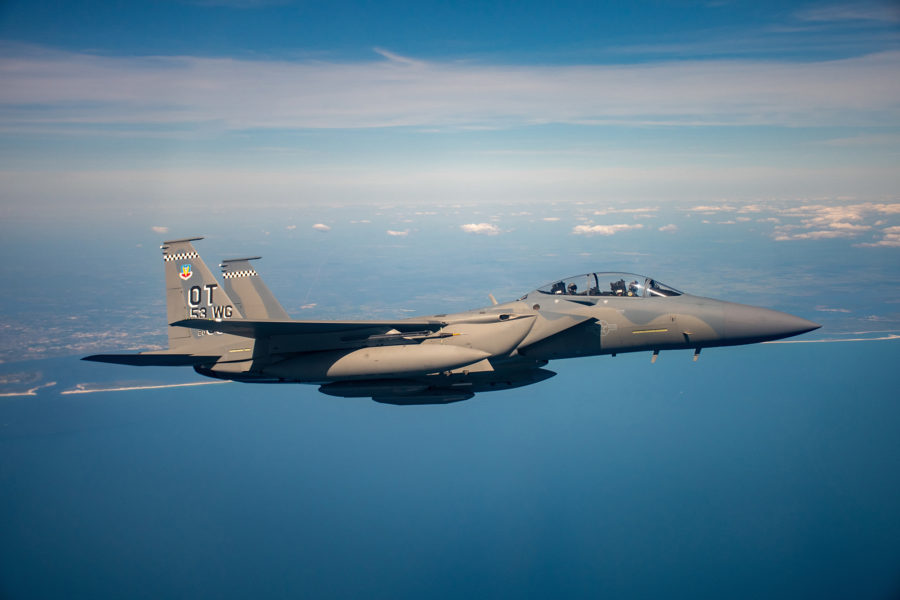The electronic warfare suite which will protect the Air Force’s F-15E and F-15EX in contested airspace has been declared “operationally effective,” the Pentagon’s test director said in its recent annual report. But the system can’t be evaluated to the very limits of its capabilities because of test range limitations, and because the Air Force doesn’t want to expose what the system can really do in open-air testing.
The 2024 annual report on major defense programs, under the signature of acting director of operational test and evaluation Raymond D. O’Toole Jr. said the Eagle Passive/Active Warning Survivability System (EPAWSS) was found to be “operationally effective, operationally suitable, and cyber survivable in the environment in which it was tested,” an assessment it summarized from a classified report. But it also noted that test range limitations—“common to all electromagnetic warfare assessments”—kept testers from fully exploring the system’s performance.
Pentagon and Air Force officials in recent years have urged more investment in test ranges to reflect a more dense and up-to-date simulation of the electronic warfare, radar, and other electromagnetic threats combat aircraft are likely to face. The full capability of EPAWSS “is unknown in modern combat environments,” the DOT&E report said, because “test capability is lacking.”
The Air Force has also said it is restricting some exercise and test activities to live, virtual and constructive environments and the Joint Simulation Environment, because open-air activities could be observed by adversaries.
The Air Force “should continue to assess and improve EPAWSS effectiveness and suitability as part of F-15EX [follow-on test and evaluation], currently planned to begin in FY25,” the DOT&E recommended.
The EPAWSS is built by BAE Systems, with Boeing as the overall integrator for the F-15E and F-15EX.
The Air Force flew EPAWSS flight test missions on the Eglin Air Force Base, Fla., test range and the Nevada Test and Training Range from August 2023 to January 2024, the DOT&E report noted.
Testers “used data from flight testing to evaluate EPAWSS geolocation performance and overall mission success. However, the data were not adequate for assessing [electronic attack] effectiveness because of shortfalls in open-air threat representation and failure to collect comparison data of effectiveness without EPAWSS.”
The evaluations included live-fly offensive and defensive counterair missions that F-15s equipped with EPAWSS flew against “various fourth- and fifth-generation Air Force and Navy aircraft” acting as threat surrogates, the DOT&E report states. One thing not evaluated was logistics and supply, because the system is not yet mature enough to be “operationally representative.”
The Pentagon report said there are still improvements to be made to EPAWSS, which it did not discuss in detail. During test flights, there were a significant number of built-in test false alarms, which DOT&E noted “have improved since the end of developmental testing.”
The secret version of the EPAWSS assessment “includes … recommendations to improve suitability,” DOT&E said. It also reported that the Mission Data File generator software “used to assemble threat parameters…is hard to use and too slow to meet updated Air Force requirements.” The Air Force’s 36th Electronic Warfare Squadron participated in the testing and “submitted 20 documented program deficiencies for the current version of the MDF generator.”
While many of the dozens of programs and systems the DOT&E office looked at in its report received criticism for slow progress or effectiveness, testers said “EPAWSS is survivable against cyber threats emulated during the IOT&E. The cyber test team was unable to generate significant adverse cyber effects on the installed EPAWSS system.”
O’Toole’s report recommended that the Air Force “continue to improve” EPAWSS in time for follow-on test and evaluation; evaluate EPAWSS against “modern threat simulators” and fix the BIT/MDF issue, and some minor issues with the Fully Automated Debrief System “to provide accurate and actionable information to aircrews and maintainers.”
In early 2025, after the timeframe covered in the report, the Air Force cleared EPAWSS for full-rate production and awarded a $615.8 million contract to Boeing to install the kits. F-15Es have already started getting the upgrade and returning to the field.
